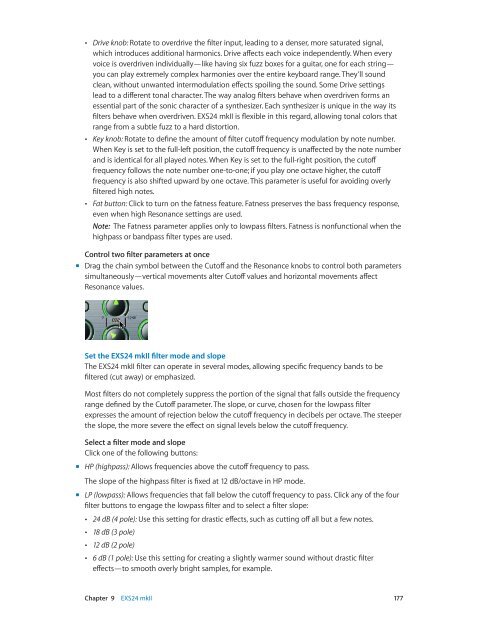Apple MainStage 3 Instruments - MainStage 3 Instruments
Apple MainStage 3 Instruments - MainStage 3 Instruments
Apple MainStage 3 Instruments - MainStage 3 Instruments
Create successful ePaper yourself
Turn your PDF publications into a flip-book with our unique Google optimized e-Paper software.
••<br />
Drive knob: Rotate to overdrive the filter input, leading to a denser, more saturated signal,<br />
which introduces additional harmonics. Drive affects each voice independently. When every<br />
voice is overdriven individually—like having six fuzz boxes for a guitar, one for each string—<br />
you can play extremely complex harmonies over the entire keyboard range. They’ll sound<br />
clean, without unwanted intermodulation effects spoiling the sound. Some Drive settings<br />
lead to a different tonal character. The way analog filters behave when overdriven forms an<br />
essential part of the sonic character of a synthesizer. Each synthesizer is unique in the way its<br />
filters behave when overdriven. EXS24 mkII is flexible in this regard, allowing tonal colors that<br />
range from a subtle fuzz to a hard distortion.<br />
••<br />
Key knob: Rotate to define the amount of filter cutoff frequency modulation by note number.<br />
When Key is set to the full-left position, the cutoff frequency is unaffected by the note number<br />
and is identical for all played notes. When Key is set to the full-right position, the cutoff<br />
frequency follows the note number one-to-one; if you play one octave higher, the cutoff<br />
frequency is also shifted upward by one octave. This parameter is useful for avoiding overly<br />
filtered high notes.<br />
••<br />
Fat button: Click to turn on the fatness feature. Fatness preserves the bass frequency response,<br />
even when high Resonance settings are used.<br />
Note: The Fatness parameter applies only to lowpass filters. Fatness is nonfunctional when the<br />
highpass or bandpass filter types are used.<br />
Control two filter parameters at once<br />
mm<br />
Drag the chain symbol between the Cutoff and the Resonance knobs to control both parameters<br />
simultaneously—vertical movements alter Cutoff values and horizontal movements affect<br />
Resonance values.<br />
Set the EXS24 mkII filter mode and slope<br />
The EXS24 mkII filter can operate in several modes, allowing specific frequency bands to be<br />
filtered (cut away) or emphasized.<br />
Most filters do not completely suppress the portion of the signal that falls outside the frequency<br />
range defined by the Cutoff parameter. The slope, or curve, chosen for the lowpass filter<br />
expresses the amount of rejection below the cutoff frequency in decibels per octave. The steeper<br />
the slope, the more severe the effect on signal levels below the cutoff frequency.<br />
Select a filter mode and slope<br />
Click one of the following buttons:<br />
mm<br />
HP (highpass): Allows frequencies above the cutoff frequency to pass.<br />
The slope of the highpass filter is fixed at 12 dB/octave in HP mode.<br />
mm<br />
LP (lowpass): Allows frequencies that fall below the cutoff frequency to pass. Click any of the four<br />
filter buttons to engage the lowpass filter and to select a filter slope:<br />
••<br />
24 dB (4 pole): Use this setting for drastic effects, such as cutting off all but a few notes.<br />
••<br />
18 dB (3 pole)<br />
••<br />
12 dB (2 pole)<br />
••<br />
6 dB (1 pole): Use this setting for creating a slightly warmer sound without drastic filter<br />
effects—to smooth overly bright samples, for example.<br />
Chapter 9 EXS24 mkII 177
















